The landscape artist intent on becoming a true hermit.
Upon scaling Gassen Ridge (“battle ridge”), one of the “3 steep ascents of the Northern Alps”, a biting wind chafes. Under the lead-colored clouds, the rocky peak of Mt.Yari casts a blue-grey silhouette, while the clouds part just enough to let through a band of light that lights up the valley floor. More than 80 years ago, this was where Hiroshi Yoshida stood.
Born in Kurume City, Fukuoka Prefecture in the 9th year of Meiji, Hiroshi Yoshida was a maestro of modern landscape painting who used traditional ukiyo-e techniques in an attempt to “create western-style paintings through woodblock prints”. As a toddler, Yoshida wandered around sketching mountains and rivers with a pen and paper. He showed great artistic promise at junior high school, and two years later moved to Kyoto and then to Tokyo in the following year to learn western painting at private painting schools. In due course, he came to realize that watercolors by Japanese artists were held in high esteem in other countries.
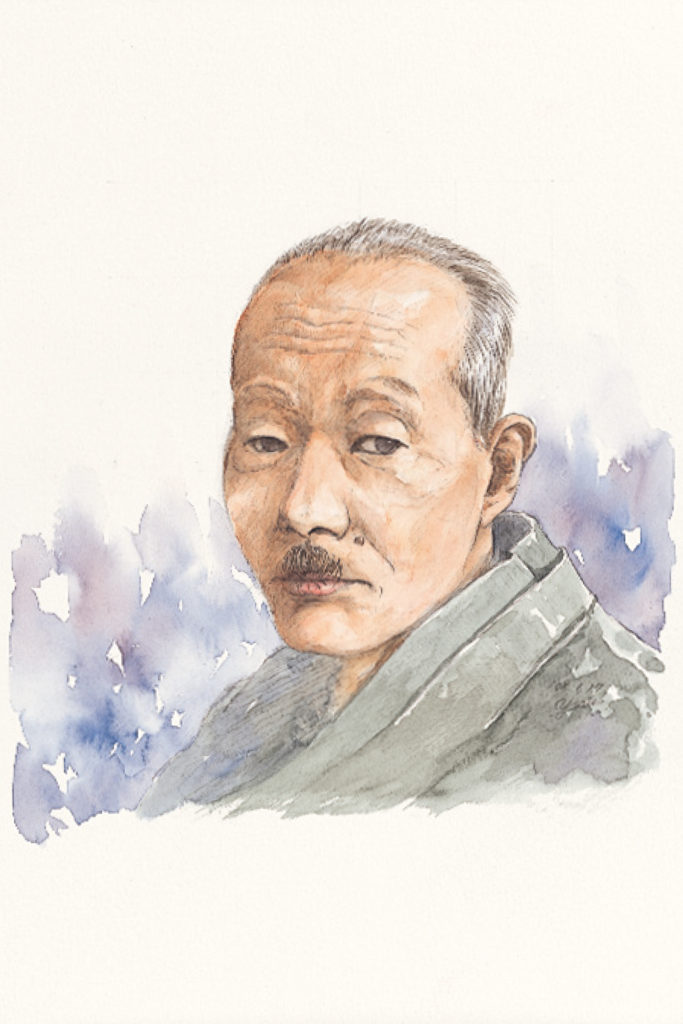
illustration | Yohei Naruse
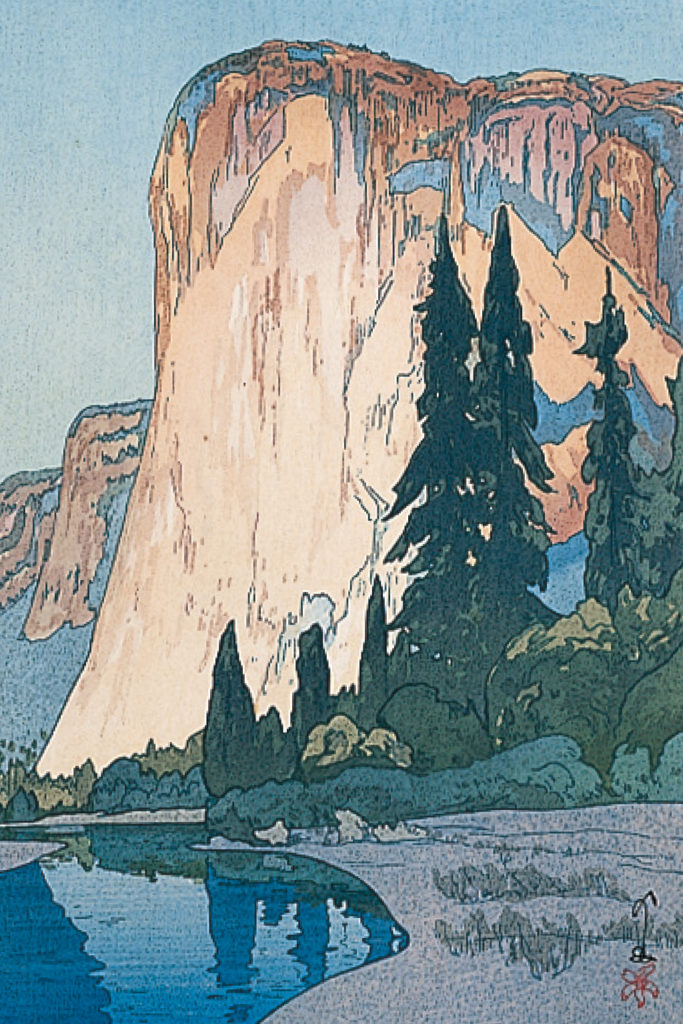
Bursting with enthusiasm and harboring a sense of rebellion towards the nascent study abroad at government expense program, this 23-year-old rookie painter resolved to never set foot in Japan again, heading instead for America with his friend from painting school Hachiro Nakagawa. The pair packed up as many of their own paintings as they could hold, scraped together the money for a one-way ticket to San Francisco and to sustain a month’s living, and hopped aboard the “America Maru”. Surviving a fire on the ship and making it to dry land in America, the two ended up holding an exhibition at the Detroit Museum of Art, which was a roaring success. And soon after the pair enjoyed another successful exhibition in Boston. The pair diverted their takings into travel funds and set sail for Europe.
Something of a drifter by nature, Hiroshi travelled far and wide in Japan but also managed 4 overseas expeditions during his seven decades on earth. Long trips would last over 3 years, and not limiting himself to Europe and The U.S., he clocked up time in Africa, India, and South East Asia. Hiroshi Yoshida was a landscape artist who moved among the hills and fields with a dogged and simple desire to depict the natural landscape. What he loved to paint above all else was mountain landscapes.
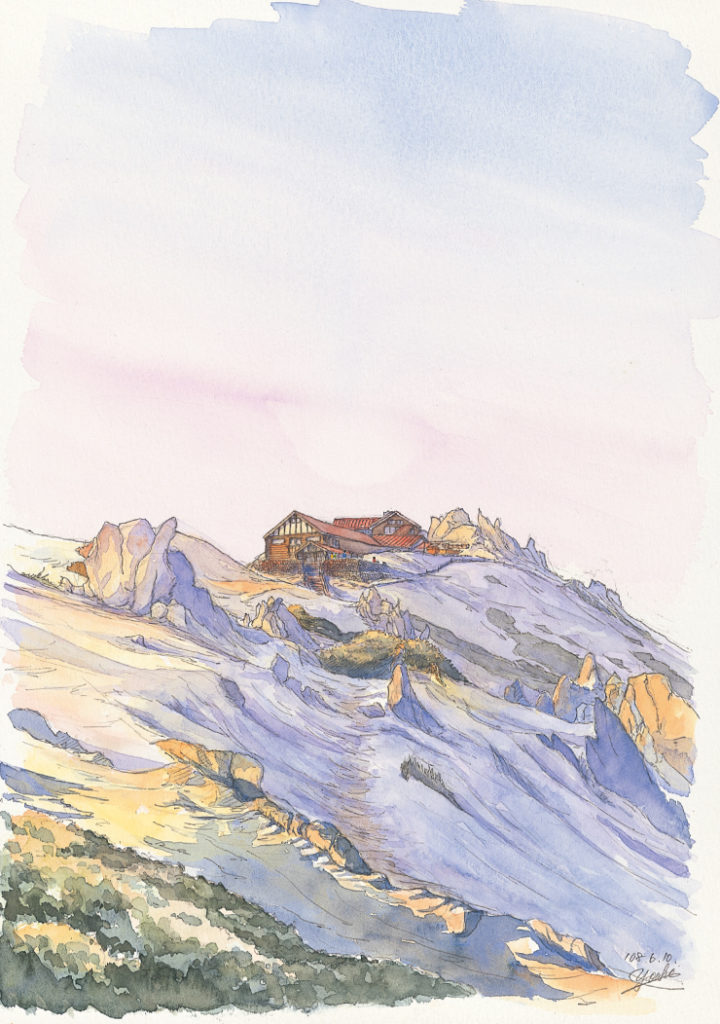
illustration | Yohei Naruse
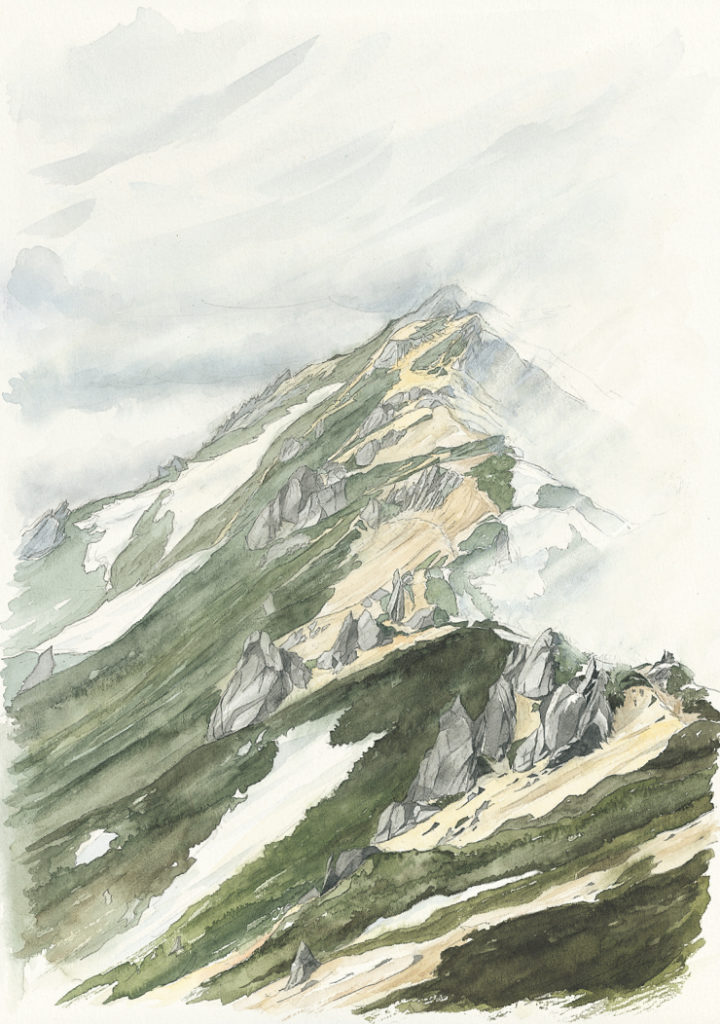
illustration | Yohei Naruse
Taking a Hike in the Footsteps of Yoshida Hiroshi
In the dead of night, the buffeting wind has blown away the clouds. Today, the weather is nice. A magnificent sea of clouds stretches out below, while mountains as far as the eye can see wait expectantly to bask in the morning sun. When at last the vermillion sun appears through the clouds to the east, the white granite of Mt.Otenso – which Yoshida described as “possessing a form that delights the artist above all others in the Japanese Alps”- is draped in a faint orange hue. Our bags packed, we traverse along the ridge that leads to Mt.Otensho, looking upwards at Mt.Yari in front. Soothing winds blow up from the valleys, carrying away the warm air.
The view from here is probably what Hiroshi sketched. With a copy in one hand, I look down on Mt. Ariake. Hiroshi Yoshida climbed every nook and cranny of the Japan Alps, leaving behind a wealth of mountain landscape paintings.
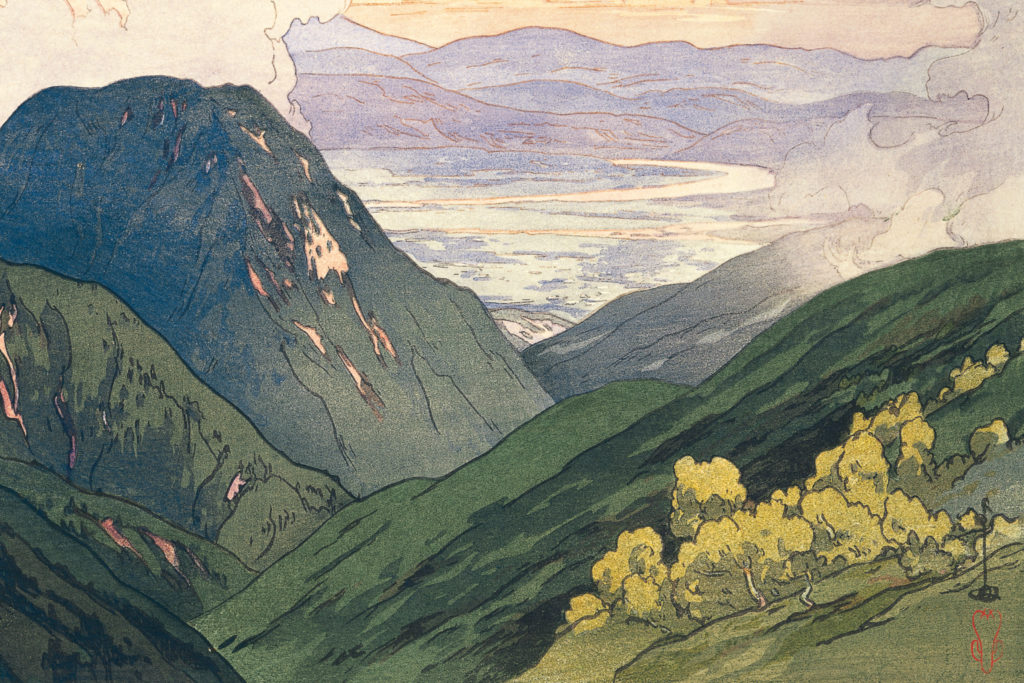
Among these is “Twelve Scenes of the Japan Alps” which he published in 1926, a collection of wood block prints depicting 12 scenes of the Northern Alps. One of these, “From Mt. Otensho”, is the scenery seen right here, of Mt. Ariake and Azumino. The position of the mountain, the way the ridge extends out, the form of the Takase river… . While the scenery isn’t a complete match, we can guess that the place he stood would have been around the valley beneath the steep climb just before the summit of Mt.Otensho.
These days, hikers are forbidden from erring off the trail, but back then there were no such restrictions, and he would have been able to wander around freely in search of the perfect composition. There is a marked element of somberness in Hiroshi’s sketches, which one imagines is to mourn Kisaki Kobayashi, a man who faithfully guided Hiroshi through his trips to the Northern Alps, and who was crushed to death together with his son in an avalanche 3 years prior to the unveiling of “Twelve Scenes of the Japanese Alps”. In the Mt. Ariake landscape, Azumino – Kisaku’s birthpace – is depicted with a pale hue.
Incidentally, Kisaku first mapped the trail from Nakabusa Hot Spring up through Mt.Otensho and then up to Mt.Yari.
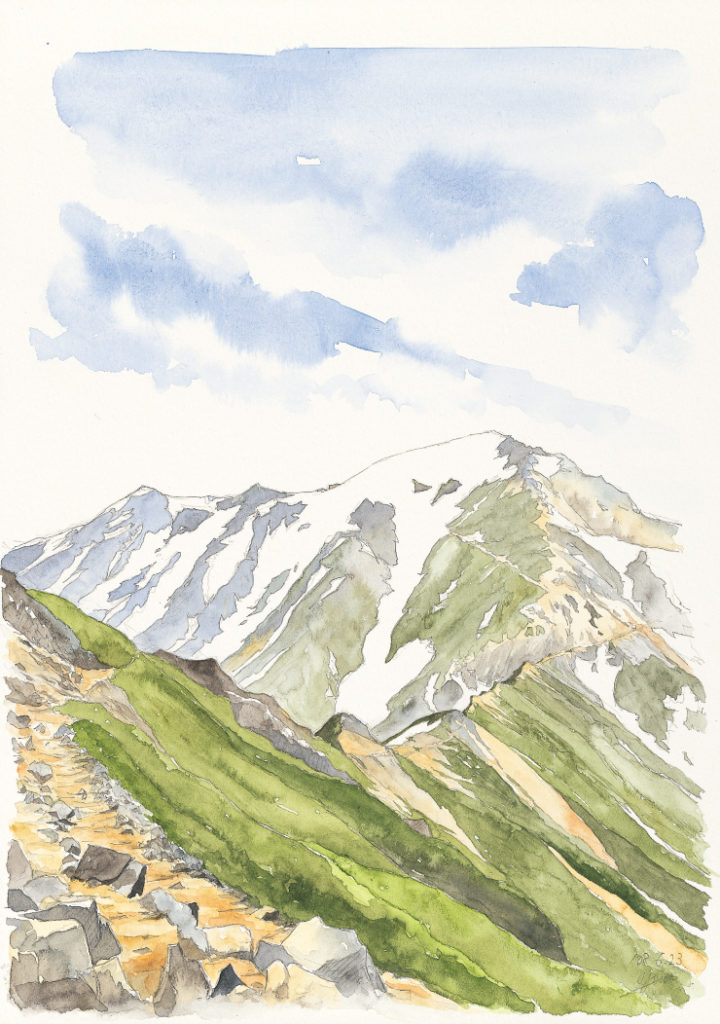
illustration | Yohei Naruse
Hiroshi Yoshida had spent boyhood days roaming around mountains in Aso and Kirishima in his native Kyushu. Camping out by choice in summer, he was no stranger to resting his head on dew-covered grassland. Holing up in the mountains on rainy nights, he could easily go a day without eating and could subsist on bush tucker, such as nuts, berries and sprouts. It wasn’t, however, simply a question of sketching nature. Descending into deep ravines overgrown with thick trees where the light can’t get in, he forced his way deep into the mountains and up peaks tinged with a certain aura of mystery, immersing himself in nature to go “full hermit”. Convinced that this was essential to depict nature in its true form, the 31-year-old Hiroshi spoke the following words. “I am committed to worshipping nature… there is nothing as diverse, and nothing greater than the force of nature. No matter what humans try to say or however much they get worked up, they are powerless in the face of nature. When an artist comes across it, they are a conduit between nature and humans, and are behooved to express the beauty of nature for those not able to witness it”. This was the starting point for his landscape paintings, and his unwavering stance towards nature.
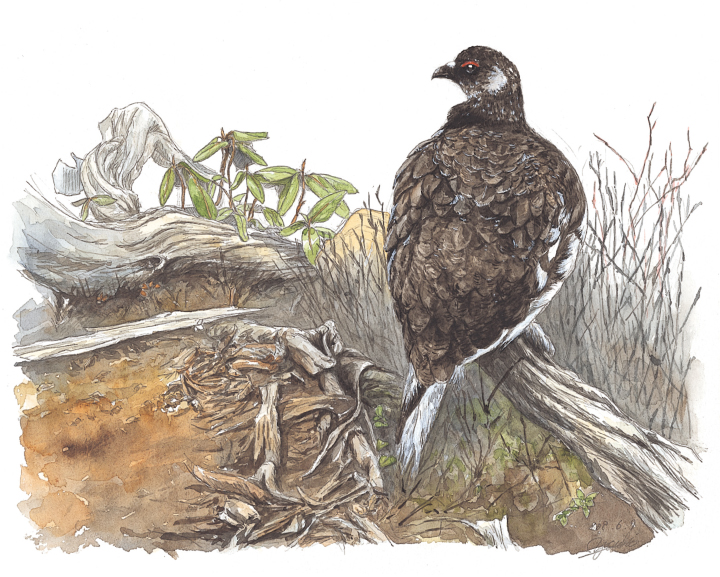
illustration | Yohei Naruse
For this series of Papersky stories I aim to revisit the places depicted in “Twelve Scenes of the Japan Alps”, finding out for myself how Hiroshi Yoshida forced his way into the mountains, how he interacted with them, and how he expressed what he saw through his art.
With a raspy chirp, a pair of ptarmigans fly off, buoyed by the wind. Before long, the warm rain of June will melt the lingering snow, and once the Dicentra peregrina blooms, the same ptarmigan will probably be back with fledglings in tow. And on we went, along the gradually sloping trail towards Mt. Jonen, thankful for a lull in the seasonal rain.
<PAPERSKY no.26(2008)>
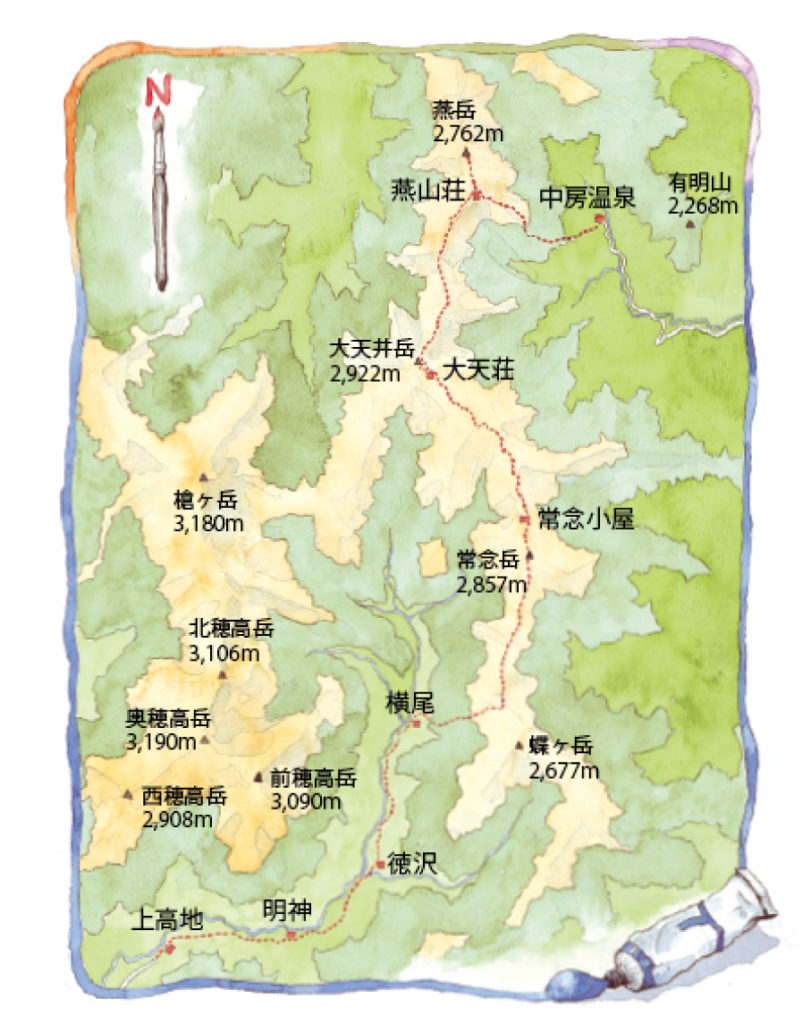
route information
While the climb up from Nakafusa Hot spring to Enzanso is steep, the trail is well-kept and easy to navigate. Enzanso is an arty mountain hut with paintings by the likes of Umetaro Azechi and Kaya Kumagai. The weary hiker is greeted by friendly staff, tasty coffee and draft beer. If you are planning a first foray in the Northern Alps, you can’t go wrong with Nakafusa Hot spring ~ Mount Tsubakuro. The ridge from Mount Tsubakuro to Mt. Otensho is known as the “Omote Ginza” route, and is very popular as it affords views of Mt. Yari. It is also of note that the trail from Mt. Otensho to Mt. Yari is called “Kisaku New Route”, as named by Hiroshi Yoshida. There is a relief sculpture of Kisaku Kobayashi on a rock face just below the summit of Mt. Otensho. Beyond Mt. Otensho is a stroll above the clouds while taking in the view of Yari and the Hotaka Range. The route that passes through Mt. Jonen down to Kamikochi is a long haul, so if you are pressed for time, you might consider descending from the Jonen Hut down through “Hie Daira” and “Mimata” (if there is no bus, order a taxi in advance from the Jonen Hut).
Yohei Naruse
Born in Gifu Prefecture in 1982. Graduated Tsuru University, Graduate School. Following a stint in advertising, he currently works as a freelance writer and illustrator.











